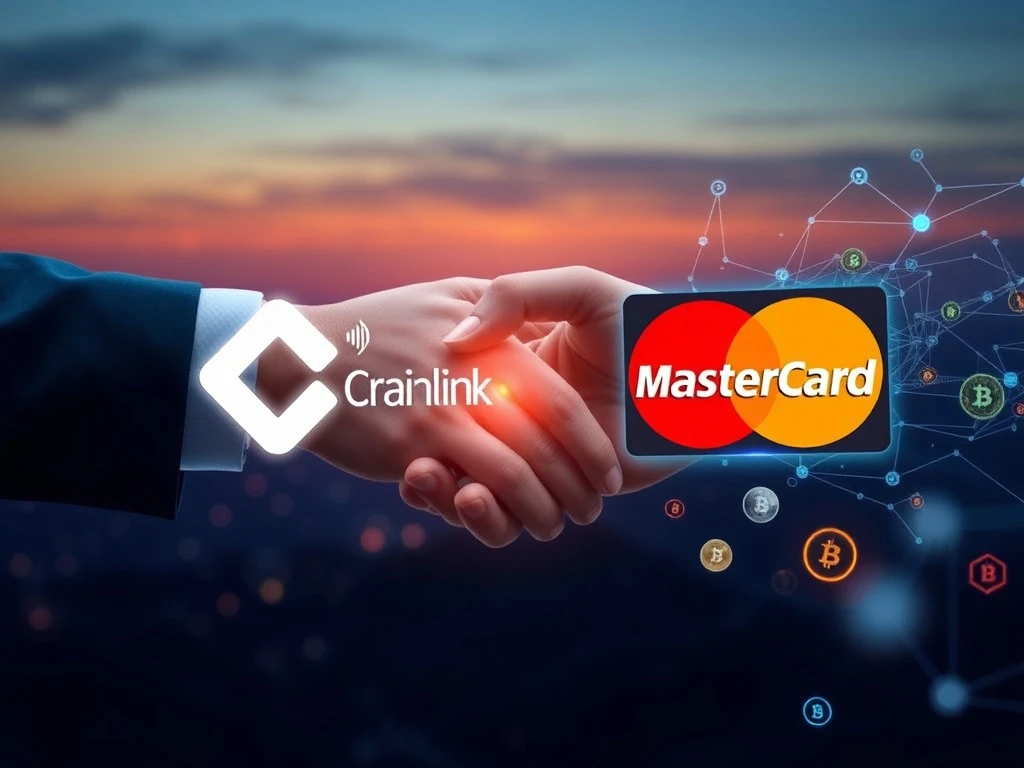Revolutionary Chainlink Mastercard Partnership Unlocks Crypto for Billions

The cryptocurrency world is buzzing with news of a monumental collaboration set to redefine how billions engage with digital assets. A groundbreaking partnership between Chainlink, a leading decentralized oracle network, and global payments giant Mastercard, aims to allow 3 billion cardholders to easily buy crypto on-chain. This development marks a significant stride towards mainstream crypto adoption, promising to simplify the process for everyday users and bridge the gap between traditional finance and the decentralized web.
Chainlink Mastercard: A Gateway to Digital Assets
The collaboration between Chainlink Mastercard is more than just a headline; it’s a strategic move designed to integrate the vast reach of Mastercard’s payment network with the secure, reliable infrastructure of Chainlink’s decentralized oracle services. This alliance intends to open a new avenue for individuals without prior Web3 exposure to gain practical experience with digital assets. By enabling direct on-chain crypto purchases for Mastercard’s extensive cardholder base, the partnership addresses a critical need for accessible entry points into the digital economy.
Chainlink, known for connecting real-world data to blockchain networks, plays a crucial role in ensuring the integrity and security of these transactions. Its decentralized oracle network is fundamental in facilitating the compliant and efficient conversion of fiat currency to various cryptocurrencies, ensuring a smooth user experience from start to finish.
Driving Crypto Adoption Through Seamless Web3 Integration
This ambitious initiative is powered by a series of strategic partnerships with specialized Web3 entities, highlighting the collaborative nature of the evolving digital landscape. These include:
- Shift4 Payments: A major payment processing company that helps facilitate the initial fiat transactions.
- Swapper Finance: Provides the user-facing application, designed to be non-custodial and leverage account abstraction for simplicity and control. This means users retain full ownership of their assets.
- XSwap: Likely contributes to the cross-chain or swapping functionalities required for diverse asset access.
- ZeroHash: A critical infrastructure company specializing in crypto and stablecoins. ZeroHash is responsible for providing the on-chain service and liquidity, enabling the direct conversion of fiat currency to cryptocurrencies.
A spokesperson from Chainlink Labs emphasized the importance of building a solution accessible to everyone, not just crypto-natives. This focus on user-friendliness and simplicity through robust Web3 integration is key to attracting a broader audience and truly driving crypto adoption on a global scale. The technical backend ensures compliance and security, while the front-end experience remains intuitive, reducing the complexity often associated with digital asset transactions.
Mastercard’s Expanding Vision for Buying Crypto
Mastercard has consistently demonstrated its commitment to the cryptocurrency space, with this latest partnership being a significant escalation of its efforts. Prior to this, the company has explored various avenues to embrace digital assets:
- Crypto Debit Cards: In 2024, Mastercard partnered with Kraken to launch crypto debit cards across the UK and Europe, allowing users to spend cryptocurrency at traditional merchants.
- Self-Custody Integration: A collaboration with MetaMask debuted a self-custody crypto card, giving users more control over their digital funds.
- Tokenized Transactions: The company reported tokenizing 30% of its 2024 transactions, indicating a deeper integration of blockchain technology into its core operations.
Mastercard’s competitor, Visa, has also been active in the crypto arena. In October 2024, Visa partnered with Coinbase for instant crypto withdrawals and deposits for some users. It also debuted a Web3 digital asset platform and invested in stablecoin payment platform BVNK. This competitive landscape underscores the growing recognition among traditional finance giants of the importance of digital assets and blockchain technology.
Overcoming Friction: The Path to Broader Digital Assets Access
One of the primary barriers to mainstream crypto adoption has been the perceived difficulty and complexity of buying crypto with fiat currency. For many, the process can be fraught with technical hurdles, security concerns, and a lack of clear guidance. This friction has historically hindered the progress of the cryptocurrency industry, despite a clear demand from consumers.
As Raj Dhamodharan, Mastercard’s executive vice president for blockchain and digital assets projects and partnerships, stated, “There’s no doubt about it — people want to be able to easily connect to the digital assets ecosystem, and vice versa.” This sentiment perfectly encapsulates the driving force behind the Chainlink Mastercard partnership. By streamlining the process of converting fiat to digital assets, the collaboration aims to:
- Simplify Onboarding: Make it easier for new users to enter the crypto space.
- Enhance User Experience: Provide a seamless, secure, and compliant way to acquire cryptocurrencies.
- Increase Accessibility: Leverage Mastercard’s global reach to bring crypto to billions.
This initiative represents a strategic effort to remove these barriers, making it as straightforward to acquire crypto as it is to make any other online purchase. The integration of established payment rails with cutting-edge Web3 solutions creates a robust and user-friendly ecosystem.
A New Era for Crypto Adoption
The partnership between Chainlink and Mastercard is a pivotal moment for the cryptocurrency industry. By leveraging the power of Web3 integration and the vast reach of Mastercard’s network, this collaboration has the potential to significantly accelerate global crypto adoption. It addresses the core challenge of accessibility, making it simpler for billions of people to buy crypto and participate in the digital economy.
This move not only validates the growing importance of digital assets but also sets a new standard for how traditional finance and decentralized technologies can converge to create more inclusive and efficient financial systems. As more users gain seamless access to cryptocurrencies, the impact on global finance, commerce, and individual empowerment will be profound, ushering in a new era of digital asset utility and widespread participation.







